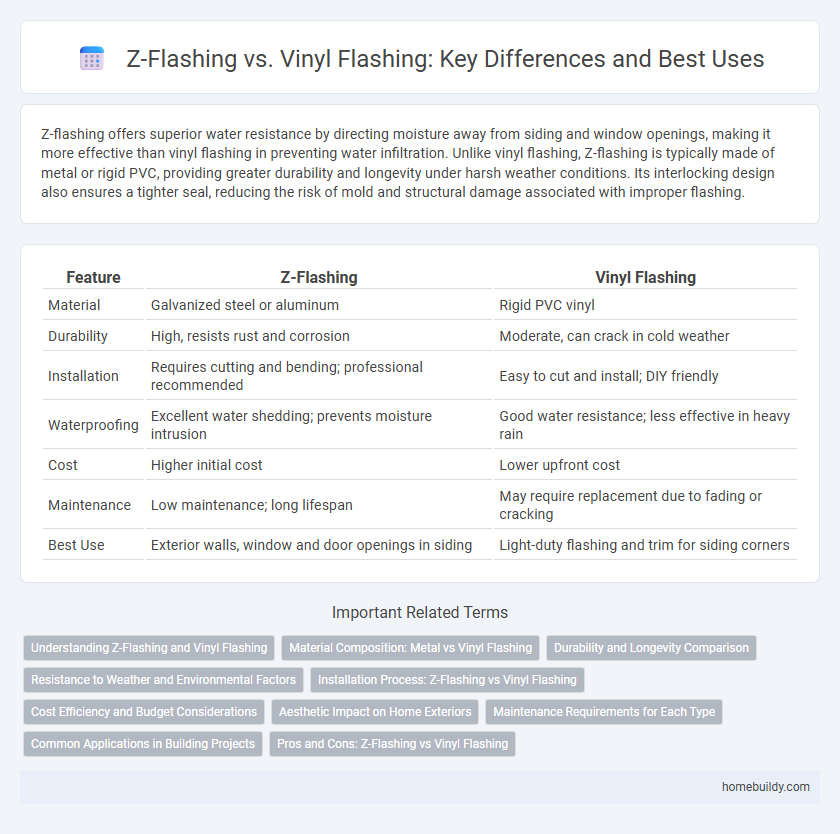Z-flashing offers superior water resistance by directing moisture away from siding and window openings, making it more effective than vinyl flashing in preventing water infiltration. Unlike vinyl flashing, Z-flashing is typically made of metal or rigid PVC, providing greater durability and longevity under harsh weather conditions. Its interlocking design also ensures a tighter seal, reducing the risk of mold and structural damage associated with improper flashing.
Table of Comparison
| Feature | Z-Flashing | Vinyl Flashing |
|---|---|---|
| Material | Galvanized steel or aluminum | Rigid PVC vinyl |
| Durability | High, resists rust and corrosion | Moderate, can crack in cold weather |
| Installation | Requires cutting and bending; professional recommended | Easy to cut and install; DIY friendly |
| Waterproofing | Excellent water shedding; prevents moisture intrusion | Good water resistance; less effective in heavy rain |
| Cost | Higher initial cost | Lower upfront cost |
| Maintenance | Low maintenance; long lifespan | May require replacement due to fading or cracking |
| Best Use | Exterior walls, window and door openings in siding | Light-duty flashing and trim for siding corners |
Understanding Z-Flashing and Vinyl Flashing
Z-flashing is a metal or vinyl strip installed between siding panels or around windows to direct water away and prevent moisture infiltration. Vinyl flashing offers flexibility and corrosion resistance but may lack the durability of metal Z-flashing, which is often preferred for long-term weatherproofing. Choosing between Z-flashing and vinyl flashing depends on factors such as material compatibility, climate exposure, and installation requirements.
Material Composition: Metal vs Vinyl Flashing
Z-flashing is typically made from metal, such as aluminum or galvanized steel, offering superior durability and resistance to weather elements compared to vinyl flashing, which is composed of PVC or other plastic materials. Metal Z-flashing provides enhanced structural strength and longevity, effectively preventing water infiltration in siding installations, whereas vinyl flashing may degrade faster under UV exposure and extreme temperatures. The choice of metal versus vinyl impacts maintenance frequency, installation techniques, and overall lifespan of the flashing system.
Durability and Longevity Comparison
Z-flashing offers superior durability compared to vinyl flashing due to its metal construction, which resists warping, cracking, and UV damage over time. Vinyl flashing tends to degrade faster under harsh weather conditions, leading to brittle edges and potential moisture infiltration. The longevity of Z-flashing often surpasses vinyl flashing by several decades, making it a more reliable choice for long-term building protection.
Resistance to Weather and Environmental Factors
Z-flashing exhibits superior resistance to weather and environmental factors compared to vinyl flashing due to its durable metal composition, which withstands extreme temperatures, UV exposure, and moisture without warping or deteriorating. Vinyl flashing tends to degrade over time when exposed to prolonged sun, fluctuating temperatures, and heavy rain, leading to cracks and reduced effectiveness. Metal Z-flashing provides a long-lasting barrier against water infiltration and environmental damage, making it ideal for maintaining structural integrity in harsh climates.
Installation Process: Z-Flashing vs Vinyl Flashing
Z-flashing installation involves securing metal strips with overlapping joints to divert water effectively, requiring precise cutting and fastening techniques for durability. Vinyl flashing is typically easier to install, using flexible strips that snap or adhere to surfaces, but it may lack the long-term resilience of metal flashing under extreme weather conditions. Proper installation of Z-flashing helps prevent water infiltration more reliably in siding and window areas compared to vinyl flashing.
Cost Efficiency and Budget Considerations
Z-flashing offers a more cost-efficient solution compared to vinyl flashing due to its durability and longer lifespan, reducing the need for frequent replacements and repairs. The initial investment in Z-flashing may be higher, but its resistance to weathering and better performance in preventing water infiltration can lead to significant savings over time. For budget-conscious projects, Z-flashing provides a balance between upfront costs and long-term value, minimizing maintenance expenses and enhancing overall structural integrity.
Aesthetic Impact on Home Exteriors
Z-flashing offers a sleek, discreet appearance that seamlessly blends with exterior siding, enhancing the home's overall aesthetic by minimizing visible flashing lines. Vinyl flashing, while functional, often presents a bulkier look with more noticeable seams that can detract from the clean design of facades. Choosing Z-flashing ensures a modern, polished finish that complements contemporary architectural styles.
Maintenance Requirements for Each Type
Z-flashing requires minimal maintenance due to its durable metal composition, resisting corrosion and damage from weather exposure. Vinyl flashing, while easier to install, demands more frequent inspections and repairs since it can warp, crack, or degrade under UV exposure and temperature fluctuations. Regular cleaning and prompt repairs extend the lifespan of both types, but Z-flashing typically offers lower long-term upkeep costs.
Common Applications in Building Projects
Z-flashing is commonly used in building projects to protect siding joints and prevent water infiltration, making it ideal for areas like window and door openings. Vinyl flashing is often preferred for its flexibility and ease of installation, especially in residential applications with vinyl siding. Both types serve crucial roles in moisture management, but Z-flashing is favored in situations requiring durable, metal-based protection.
Pros and Cons: Z-Flashing vs Vinyl Flashing
Z-flashing, typically made from metal like aluminum, offers superior durability and weather resistance compared to vinyl flashing, which can warp or crack under extreme temperatures. Vinyl flashing is more affordable and easier to install for DIY projects, but it lacks the long-term structural integrity of Z-flashing, which provides better protection against water infiltration. Despite higher initial costs, Z-flashing's longevity and robustness make it a preferred choice for siding and roofing applications exposed to harsh elements.
Z-flashing vs vinyl flashing Infographic

 homebuildy.com
homebuildy.com